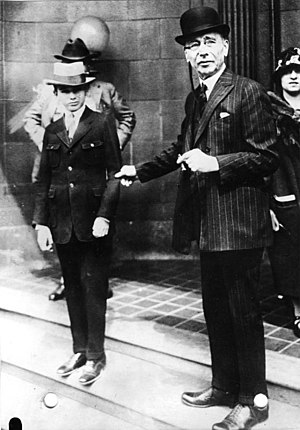Leopold and Loeb "Thrill Kill" Bobby Franks, 1924
 |
| Loeb (left) and Leopold (right) in 1924 |
The two young men decided it would be a fine test of their mental abilities to kidnap a young boy and hold him for ransom. In order to avoid detection, they had already decided to kill the victim. They did not decide ahead of time on who the victim would be, just that it needed to be someone they were acquainted with so that it would be easy to lure him into the car.
 |
| Bobby Franks with his father |
They drove the body to a remote area and dumped it in a culvert, pouring hydrochloric acid over the face and genitals. They called the Franks and told them their son had been kidnapped and then mailed the ransom note. They burned the clothes they had been wearing and cleaned the car before returning it to the rental agency. They then spent the evening playing cards.
The next morning, before Franks could leave with the ransom payment, the police called to notify him that they had found Bobby's remains.
For such an intelligent pair, they made a great many mistakes. A pair of eyeglasses was found near the body, containing an unusual hinge mechanism. Only three people in the Chicago area had purchased such a hinge; one of them was Leopold. They sent an elegantly worded ransom note, indicative of someone with a good education. And they hadn't even worked out an alibi.
Leopold told authorities that he had been out on a double date with Loeb, but couldn't furnish many details about the girls. Loeb said that the two had separated early in the evening. Eventually Loeb switched to Leopold's story, unfortunately for him. The pair claimed that they had been out in Leopold's car -- which Leopold's chauffeur had been repairing that night. They had also been seen in the rental car minutes before the kidnapping.
Eventually the two confessed, Loeb confessing first. He claimed that Leopold had struck the actual death blow. Leopold claimed that Loeb had done it.
 |
| Clarence Darrow was the defense attorney. |
Both boys were sentenced to life imprisonment for the murder and an additional 99 years for the kidnapping. The judge recommended that they never be released on parole. Richard Loeb was killed by his cellmate, James Day, in 1936. (Day emerged without a scratch and Loeb had more than 50 wounds and had apparently had his throat cut by someone standing behind him. The prison accepted Day's claim that he had acted in self defense.)
Nathan Leopold was released on parole after 33 years in prison. He moved to Puerto Rico where he worked as a lab and x-ray assistant, and died of natural causes in 1971.
Louis Slotin Fatally Irradiated, 1946
 |
| Louis Slotin |
The screwdriver slipped, and the upper sphere fell, which caused a sudden burst of hard radiation. Observers said there was a blue glow and a sudden wave of heat. Slotin jerked his hand upward, raising the beryllium half-sphere and dropping it on the floor, which stopped the reaction and saved the lives of the seven bystanders. He, however, had already been exposed to a radiation dose that was about four times a lethal dose. He died of radiation poisoning nine days later.
 |
| This is a simulated recreation of the fatal event. |
No comments:
Post a Comment